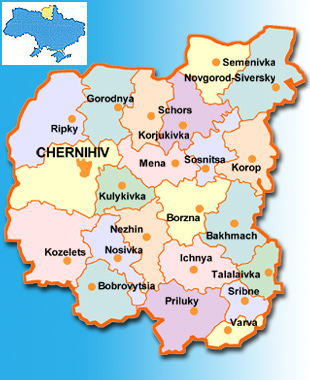
|
Overview of Chernihiv Oblast
Population:1.32 million |
The Chernihiv region was formed on October 15, 1932. It is located in the north of Ukraine, on the left bank of the Dnipro mid-current, in the Desna basin. The region is one of the largest in Ukraine, occupying 5% of its area.
The uniqueness of the economic and geographical position of the region is determined by its location on the border of three countries, Ukraine, Russia and Belarus, its proximity to Kyiv, the capital and large industrial center, and its well-developed transport system. The region's territory is crossed by main railways and highways of international significance, air and river transport are also highly developed. The population of the region is 1,320,000, with about 800,000 people employable.
The Chernihiv region lies within the geographical zones of mixed forest and forest-steppe; the forests cover 20% of the area. The climate in the region is temperately continental, with sufficient precipitation, warm in summer and comparatively mild in winter. The water network of the Chernihiv region includes 1,200 rivers, with the total length of 8,000 km.
The Chernihiv region is one of the few regions in Ukraine with considerable tourist and recreational potential. 655,000 hectares or over 20% of the region's area could be used for both long- and short-term recreation favored by the climatic conditions and diverse flora and fauna. Out of the regionís 585 natural reserves, 18 are of the national significance. Mineral water sources and bischofite (CL2Mg) used as a balneal remedy add to the therapeutic resources of the region. There is developed resort network including holiday centers, sanatoriums, camps, summer camps for children, hunting and fishing centers, boat stations, beaches, and forest parks.
The bowels of the Chernihiv region contain large deposits of various minerals and natural raw materials that can be divided into two major groups: energy sources (oil, gas, condensate, and peat) and construction materials. There are important amounts of high quality quartz sands, oil, peat, chalk, and materials for brick production. The region has about 15 deposits of clay suitable for production of roofing and facing tiles, pottery and artistic ceramics. There are mineral water sources in several districts of the Chernihiv region.
The region is extremely famous for its large number of brilliant relics and monuments of history and architecture of the 11-12th and 17-19th centuries. More than 200 of them are considered of global significance and evidence the outstanding role of the Chernihiv Principality in the formation of the Kyiv Rus, the first Slavonic State.
The region has a combined industrial-agricultural economic structure. The industrial sector produces more than 70% of wool fabrics and wall-paper and 30% of chemical fibers and threads manufactured in the whole of Ukraine. It is the only Ukrainian region producing cord fabric, fire-engines, protein casing, pianos, and certain kinds of agricultural machinery. The priority in the industrial structure is given to the food-processing, fuel, machine-building and light industries. The forestry, woodworking, pulp-and-paper, power, chemical and petrochemical industries are also of considerable significance.
The region has a considerable agricultural potential. With 2,114,000 hectares of arable land, it is one of the most developed agrarian regions of Ukraine. Intensive land-cultivation techniques are applied, with a large share of technical crops. Different zones of the region have their own agricultural specialization. While grain crops are grown throughout the region, potatoes and flax growing is developed in the Polissia area and sugar beets are cultivated in the forest-steppe zone. Cattle farming is an important agricultural segment. The agriculture of the region produces nearly all kinds of products (except vegetable oil and fish) to satisfy the local populationís needs for food, and most of the products have considerable exports potential.
The factors making the Chernihiv region attractive for investing include:
- geographic position at the border of three countries (Ukraine, Russia and Belarus),
- abundant natural resources,
- branched network of motor roads, railways and waterways,
- immediate proximity of the capital region,
- political stability and relatively low risks,
- considerable industrial, scientific and technological potential,
- export orientation of the regional economy,
- availability of inexpensive and qualified labor force,
- access to the markets of Ukraine and the CIS countries, and
- developed banking system.
As of April 1, 2000, the total investment in the regional economy amounts to USD 46.85 million. The major investors are Great Britain, Belgium, the Netherlands, the USA, Luxembourg, and Russia. The largest share of investment is received by the food industry (91.2%) followed by communications (8.5%), trade (1.9%) and light industry (1.8%). The primary investment needs of the regional economy include technological upgrade of food-processing and light industries, introduction of advanced technologies of processing agricultural products, potatoes and vegetables in particular, producing pasta, vegetable oil, and mineral water, and fabricating modern packaging materials and energy-saving construction elements.
The Presidential Decree dated May 27, 1999 "On Special Investment Regime in the Territories of Priority Development of the Chernihiv Region" makes seven northern districts of the region more attractive for investment providing important incentives to foreign investors, which is expected to result in increased influx of investments into the region.